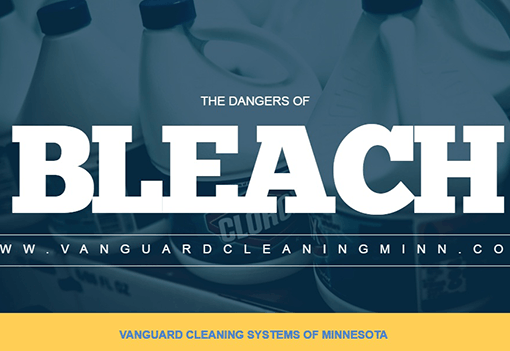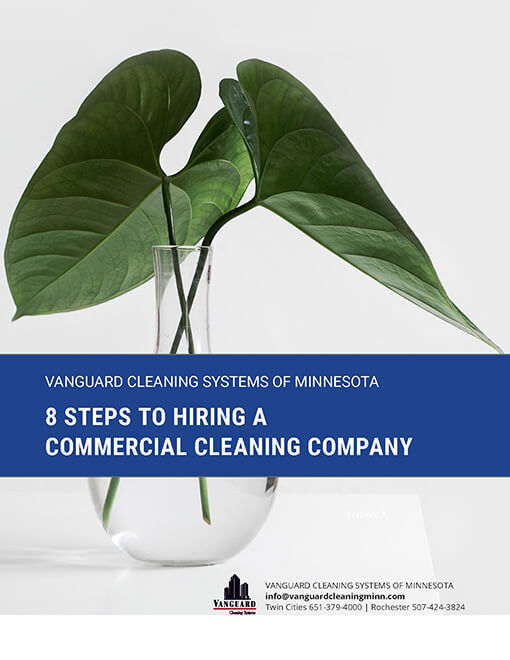Vanguard Cleaning Systems

Dangers of Bleach in Office Cleaning
In this edition of our ongoing janitorial services tips and advice series, we take a look at the hazardous use of chlorine bleach for conventional cleaning services applications, as well as review safer and healthier alternatives.
In This Article
Cleaning Services Tips and Advice for Chlorine Bleach use in Businesses, Homes, and Schools
Chlorine bleach, due to its wide range of applications, is one of the most commonly employed disinfectant cleaners in the United States.
With the proper dilution percentage per volume of water, depending on the percentage of sodium hypochlorite contained in the bleach, use has been approved as safe for:
- Disinfecting surfaces in homes, schools, and healthcare facilities, particularly in the prevention of hospital-acquired infections (HAI).
- Preparing emergency drinking water, as well as disinfecting private wells, and;
- Safely cleaning and disinfecting laundry.
However, long-term exposure to bleach fumes or direct skin contact has been shown to contribute to significant health problems, especially in children.
Bleach is particularly harmful to infants, young children and pets because their immune systems cannot fight off the harsh chemicals. Exposure to bleach can irritate the nose, eyes, skin, and lungs. Serious side effects of using bleach can include respiratory problems, skin burns, damage to the nervous system, asthma flares, extreme headaches, migraines, and vomiting.
The Dangers of Bleach
Fortunately, science and technology have advanced to the point that safer, healthier, and more effective products are emerging in the consumer and commercial cleaning services markets.
Using Bleach Safely
The simple truth is that bleach is a dangerous, corrosive chemical compound, especially when it comes into contact with humans or animals, particularly young children, or those with compromised respiratory or immune systems.
The problem?
Most people and many cleaning services providers don’t follow the safety guidelines or ignore hazard warnings.
To use bleach safely:
- Know what strength the bleach is by identifying the sodium hypochlorite percentage.
- The EPA recommends a solution percentage of 8.25% for commercial disinfecting, however;
- Consumer available bleach purchased at the grocery store is, typically, only 5.25%.
- Dilute the proper measurement of bleach per gallon of water as described on the product label.
- Always keep bleach out of the reach of children.
- Ensure bleach is used in well-ventilated areas.
- Store at room temperature, as higher temperatures will cause the bleach to evaporate.
- Allow for the proper lay-time, per the manufacturer’s instructions, for surface and liquid disinfection.
- Use a microfiber mop or towel with water to clear away any remaining film after the lay-time is complete.
The Dangers of Chlorine Bleach Use
The manufacture and disposal of bleach are harmful to the environment, especially when manufactured in mercury-cell plants.
Despite widely published and accepted reports of the dangers of mercury use, there were, as of 2002, still nine plants operating in the United States.
According to Oceana;
There are nine mercury-cell chlorine plants still operating in the United States, located in eight states: Alabama, Delaware, Georgia, Louisiana, Ohio, Tennessee, West Virginia and Wisconsin. According to the industry’s own reported estimates, the average mercury-based chlorine plant released 1097 lbs (499 kg) of mercury to air in 2002.
Poison Plants: Chlorine Factories are a Major Source of Mercury
Fortunately, Clorox does not purchase from these plants.
However, they do acknowledge that 2% – 5% of bleach byproducts are not biodegradable, and must be handled by municipal water and sewage treatment.
During use and disposal, 95% to 98% of bleach rapidly breaks down back into salt and water. The remaining byproducts are effectively treated by municipal wastewater and septic systems. Bleach does not contaminate groundwater because it does not survive sewage treatment, either in municipal sewage treatment plants or in septic systems. No dioxins are formed.
Cleaning with Bleach: Facts and Information
Regardless, even passive exposure to bleach has been shown to contribute to negative health issues, especially in children.
According to a 2015 study, published in Occupational and Environmental Medicine;
Passive exposure to cleaning bleach in the home may have adverse effects on school-age children’s health by increasing the risk of respiratory and other infections. The high frequency of use of disinfecting irritant cleaning products may be of public health concern, also when exposure occurs during childhood.
Domestic use of bleach and infections in children: a multicentre cross-sectional study
Bleach Alternatives
Fortunately, several DIY, home, and commercial alternatives exist that should replace the excessive and unnecessary exposure to bleach and chlorine we subject ourselves and our planet to on a daily basis.
- For businesses, consult with a professional green cleaning services vendor to replace bleach with Green Seal certified sanitizers and disinfectants.
- Alternatively, look towards emerging chemical-free cleaning technologies.
For home use, follow the same general advice as provide with businesses, and focus your purchasing decisions based on product certifications from Greenseal
DIY Bleach Alternatives
- Why we all Need to Stop Cleaning With Bleach
- Bleach
References and Resources
- How to Use Bleach
- Emergency Disinfection of Drinking Water
- Bleach 101
- Bleach FAQ’s
- Making cleaning solution from 3.5% liquid bleach
- The Dangers Of Household Bleach: Kids Exposed To Cleaner May Experience Respiratory Illness, Infections
Takeaway
When used appropriately, following the specific safety guidelines, bleach use can be highly-effective at disinfecting a vast array of surfaces, as well as drinking water in emergencies.
However, even though bleach does break down, almost entirely, a small percentage of toxic byproducts remain, which must be handled by the purification process of sewage treatment plants.
Additionally, bleach is readily absorbed through the skin and respiratory system and is linked with multiple, chronic illnesses, especially in children who are overexposed to the product.
Green cleaning services, products, and practices provide a safer, healthier bleach alternative that is better for humans, pets, and the environment, without sacrificing disinfecting power.
Search Our Blog
Subscribe to Our Blog
TAKE ACTION
Ready to hire a new commercial cleaning company?
Vanguard Cleaning Systems of Minnesota can help you compare commercial cleaning companies and consider all your options before you make a move. Download our free guide, “8 Steps to Hiring a Commercial Cleaning Company”

